Distal Biceps Rupture Surgery

In my practice I prefer to use 2 small incisions to allow the most anatomical repair therefore restoring near to normal function.
- Dr Duckworth
The sooner you are seen after you rupture your tendon the easier it is to repair.
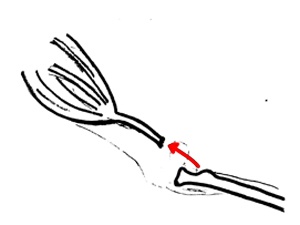
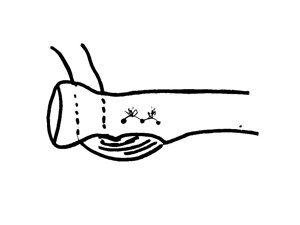
The distal biceps tendon ruptures off the bone called the radius at its proximal end near the elbow joint.
The part of the radius it arises from is called the radial tuberosity. This part of the radius rotates around the other bone in the elbow called the ulna allowing the motion of rotation. The biceps tendon has to be surgically repaired to this anatomical part of the radius to allow full function to occur. The tendon can be repaired in 2 different ways using either one or two incisions. In my practice I prefer to use 2 small incisions to allow the most anatomical repair therefore restoring near to normal function.
Beyond 4 weeks after the injury it is very difficult to repair and the results are not as rewarding. The tendon after the rupture starts to retract up the arm and gets to a stage after 4 to 6 weeks where it can not be brought down to its anatomical position of attachment.
Learn more about distal biceps ruptures
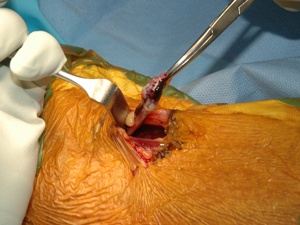
The first incision is made in your elbow crease at the front of your arm. This incision is about 3 cm long and through this exposure we find your ruptured tendon.
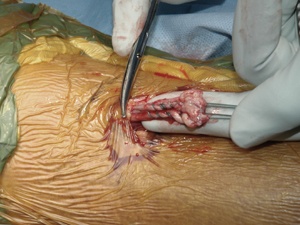
Sutures are then woven up and down the tendon and these are then used to reattach the tendon to the bone (radial tuberosity).
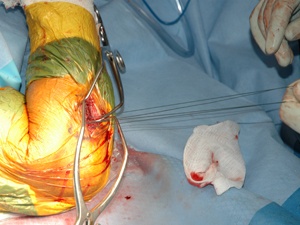
A second incision is then made at the back of your elbow over the bone called the radial tuberosity. Through this incision we dissect onto the bony attachment site for the tendon, little drill holes are made in this bony prominence for reattachment of the tendon. The biceps is then pulled through the top incision and down to the second incision, the sutures are pulled through the drill holes and the tendon reduced to its normal anatomical position.
Once the tendon is reattached we put your elbow through a normal range of motion to check all is secure and functioning normally.
It is now up to the tendon to heal back to the bone and for your elbow to slowly regain function.
What happens after surgery?
The surgery generally takes about an hour. Your elbow is placed in a bandage and also a sling to protect the repair. No plaster is necessary. This operation can be performed as a day only or sometimes an overnight procedure. I get you to start moving your elbow the next day to prevent stiffness. The movement you start doing is called passive which means you get your other hand to hold your affected wrist as you move your arm to prevent a load being placed through the repair. I start with 2 exercises which are passive flexion and passive supination during the first 6 weeks as seen in the pictures.
Unfortunately for the majority of the remaining 6 weeks you have to rest your arm in the sling to allow the tendon to heal.
PASSIVE FLEXION
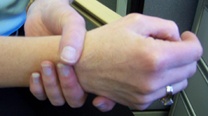
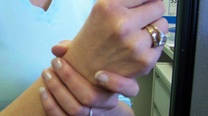
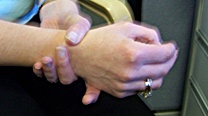
PASSIVE SUPINATION
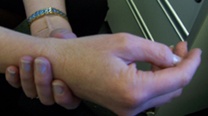
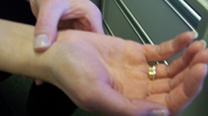
How long am I in hospital for?
Often just one day but maybe overnight depending on how you feel after your general anaesthetic.
What can I do in a sling?
During this 6 weeks you can take your arm out of the sling when sitting down or resting. One can generally do simple tasks such as using keyboards, eating and drinking. No weight heavier than a full coffee cup should be put through your elbow during this time of healing.
After 6 weeks a physiotherapy programme is started so you regain strength and function in your arm. It takes 4 to 6 months for your elbow to recover and feel reasonably normal. Heavy loads should not be put through your elbow in this time.
What is the success rate of surgery?
In my hands most patients are very happy with the operation and are very glad they have had it performed. The majority of patients recover their full range of motion and strength after a 4 to 6 month recovery period. Most patients can return to their pre-injury functional level after this period of time.
When can I drive?
You cannot drive whilst wearing a sling so not for 6 weeks.
When can I return to work?
It really depends on the type of work that you do. If your work is office based and desk work you could expect to be back at work within a week or 2 so long as you had some way of getting there. Any work involving heavy lifting would need to be avoided until 4-6 months after your surgery.
What complications can occur with this operation?
The complications after a distal biceps repair are very small but possible. Firstly, if the tendon is of poor quality it maybe irreparable. Some of the other complications include nerve damage as the tendon travels close to major nerves in your arm, blood vessel injury, and rerupture of the tendon. The other major complication that can occur is where your tendon repair heals rapidly causing extra bone to develop and subsequent loss of rotation of your forearm. If this occurs then a second operation is necessary to remove the bone so as to allow the rotation to recur.
For specific advice regarding biceps repair surgery, please book an appointment with Dr David Duckworth on (02) 9806 3333
For appointments and enquiries, please phone (02) 9806 3333
8am to 5pm, Monday to Friday
© 2008-2024 Dr David Duckworth